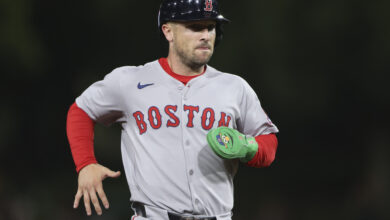
MLB Making Uncharacteristically Good Decisions Between Early CBA Talks, Potential Changes to Streaming Rules
Major League Baseball isn’t known for it’s exemplary decision-making when it comes to how to best market its product to fans, but two recent developments indicate a potential sea of change in the works. The first of those includes the labor relationship between the league and players, a tenuous partnership that has appeared close to falling apart completely as of the December 1 expiration of the CBA.
Though the possibility of a work stoppage still looms, ESPN’s Jeff Passan reported that the two sides met Tuesday for their first formal negotiating session. Dozens of people, including players, joined the videoconference that represented the first talks between the league and union since before the start of the abbreviated restart of the 2020 season.
It’s going to take a lot of work to patch over the damage done by all the sparring over the last few years, particularly as the players have lost any lingering trust in ownership’s claims about the sport’s financial well-being. The league is going to want expanded playoffs and will likely push for changes to the rules that are meant to make games more exciting, whatever that means.
The union will want a larger piece of the financial pie, or at least to have more money allocated to players in the early years of their careers. One of the biggest failures of the previous CBA negotiations was the union settling for enhanced creature comforts like better clubhouse food and more space on flights rather than eliminating loopholes like service-time manipulation.
Even if one meeting can’t come close to solving any issues, it’s a good sign that it took place at all. The average fan isn’t really paying attention to that, but another very positive development would have a huge impact on how we are able to consume MLB’s product. Assuming, that is, there’s still a product to consume.
According to a report from Rob Pegoraro of Fierce Video, MLB is considering big changes to its broadcast rules that would enable regional sports networks to stream games directly to consumers without the need to authenticate through a carrier. As things currently stand, a viewer must have access to a given RSN via their cable or satellite provider in order to stream games through their smart TV or mobile device.
There is also MLB.tv, which enables subscribers to access any out-of-market streams, but that does no good for cord-cutters who want to watch a local broadcast. Unless, of course, those folks mask their IP or use a VPN that allows them to say they’re in another area, but the key here is that some of those limitations might be going away.
“What we’re trying to do now is work with those RSNs to figure out what type of structure would make sense for an over-the-top product that may not require authentication,” MLB’s chief operations and strategy officer Chris Marinak told the Stream TV Sports Summit.
While admitting that there isn’t currently a blueprint for what such a direct-to-consumer offering would look like, Marinak said MLB has “basically done a 180” when it comes to content distribution. One example of that shifting mentality is Film Room, a searchable library of clips that allows fans to curate their own highlight reels. Finally getting away from the traditional broadcast model would be a huge step toward MLB actually reaching out to more of the younger fans it claims to want.
That would play right into the hands of Sinclair Broadcast Group, which has begun rebranding its RSNs as part of a partnership with Bally’s. As clunky and sort of Atlantic City-ish — or old-school gym-ish — as the new channels sound, the goal has been to push into standalone offerings that would exist alongside traditional cable models.
“We have a pretty aggressive plan,” Sinclair president and CEO Chris Ripley told financial analysts last November. “It will happen next year.”
Ripley’s timeline might not be all that aggressive in general, though it’ll almost certainly be 2022 at the earliest before MLB games are offered in such a manner. And if you’re getting your hopes up about an end to blackout restrictions, you may want to prepare yourself for the likelihood of bad news on that front. During his summit address, Marinak noted that MLB wants to maintain control over where live games can be broadcast.
As disappointing as that is for the immediate future, the fact that MLB is discussing potential changes publicly is a very good sign. And while the continuation of blackout rules is even more foolish in the face of standalone RSNs, this would be another step toward their eventual elimination.

